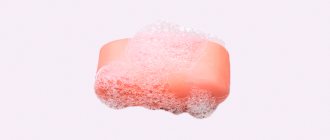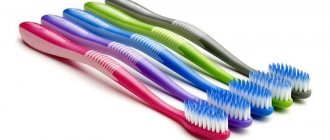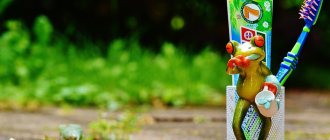Prevention of dental diseases begins with proper use of a toothbrush. It is important not only to have a good tool and brush your teeth regularly, but also to change it in a timely manner so that it does not turn from a means of protection into a risk factor.
Why do you need to change your toothbrush, how often should you do it and how to properly care for it? Information about all this is provided below.
Why does the brush need to be changed regularly?
There are two reasons why you should do this:
- The more worn your toothbrush is, the easier it is for bacteria to hide in the loose bristles.
Over time, any brush stops cleaning your teeth effectively. Special studies have shown that the bristles of an instrument that has served its owner for more than 3 months wear out, flake and become too soft, as a result of which they no longer effectively remove plaque.
- Any brush accumulates pathogenic microorganisms. And the more worn it is, the easier it is for bacteria to hide in the exfoliated bristles. Even if a person does not suffer from any infectious disease, a huge number of opportunistic bacteria multiply in the toothbrush over time, which, under certain conditions, cause diseases of the gums and teeth, or even lead to systemic infections.
Irrigator
This is a special device that helps remove plaque and food debris using water or medicine. According to dentists, using an irrigator instead of floss and brush is much more effective for the entire oral cavity.
The irrigator (aerator) includes a compressor or hydraulic pump, a water container, a set of different nozzles and a comfortable handle. Water or medicinal liquid is supplied into the mouth by a compressor through a nozzle under pressure. This cleaning removes food debris and plaque, improves blood circulation in the gums, and makes them stronger.
The attachments include classic, periodontal, orthodontic, nasal, with a mini-turbine or a spoon for cleaning the tongue. Irrigators can be used for prevention or therapy if a special solution can be used instead of water. There are devices where water is supplied by pulsation or air microbubbles. The device can be used in any environment, it is only important that there is a charged battery or power supply.
How often should this be done?
In general, dentists recommend changing your toothbrush every 3 months. Some recommend doing this even more often - every 1.5-2 months.
For an adult
The optimal replacement period for adults is 2-3 months. If a person has had some kind of infectious disease, then the instrument should be changed immediately after recovery.
To kid
Children should be taught to use a brush that is familiar to all of us, starting from the age of one year.
The relationship between kids and toothbrushes is a special story.
Children should be taught to use the brush that is familiar to all of us, starting at one year of age.
First, to clean your teeth, use a bandage or napkin soaked in warm, always boiled, water.
Starting from 6 months, a special cap with a platform on which there is a small soft bristle is used.
The mother puts the cap on her finger and gently brushes the baby’s teeth with it.
For babies over one year old, use a children's toothbrush with soft, always artificial (it accumulates less bacteria) bristles.
Electric tools for children can be used starting from 2-3 years old, but you need to be careful.
Do not hold the cleaning head in one place for a long time or press it firmly against the child’s teeth. In general, experts advise buying electric tools for children starting from 6 years old.
You need to teach your child to brush their teeth from the age of one. It is considered normal if this hygienic procedure becomes habitual for a baby at 2-3 years old.
The optimal service life of a child’s brush is the same as for an adult’s – 2-3 months. Moreover, if children have had a cold or other disease (tonsillitis, stomatitis, thrush), the instrument must be changed in any condition.
Some more useful tips
If it is not changed in time, then instead of doing good, it will only cause harm. Such an item for cleaning teeth damages tooth enamel, promotes the spread of pathogenic microbes, and leads to inflammation of the gums.
Any thing or object becomes unusable during use. A toothbrush is no exception. While it is new, you can brush your teeth and remove plaque with it without any problems. After a certain time, the bristles on the toothbrush begin to wear out, break, become deformed and become shaggy.
It is already dangerous to take care of the oral cavity with such an instrument; it can damage teeth and gums. In addition, even if the brush looks good and has not lost its original appearance, but is used for a long time, pathogenic microflora still multiplies in the villi. It will definitely get into the mouth of the owner of the brush and provoke an inflammatory process and dental diseases.
Both adults and children should definitely brush their teeth. Parents brush their babies' first teeth using a silicone fingertip. It is very easy to use and easy to clean. The fingertip should be replaced with a new one as it wears out.
As the child gets older, he brushes his teeth with a brush that has bristles. When used, the bristles deteriorate, lose their original appearance and perform their function worse and worse. In addition, over time, pathogenic microbes begin to develop in the toothbrush.
The baby may develop caries, stomatitis, tonsillitis and other diseases. In order not to injure the child’s teeth and gums, as well as to avoid health problems, it is imperative to change the brush with a new one every two to three months, that is, 4-6 times a year.
Adults should monitor not only the health of their children, but also their own. A damaged and long-used personal toothbrush can cause serious damage to the gums and teeth of an adult. As a result, you will have to undergo long and persistent treatment.
Most toothbrushes have colored bristles, which act as an indicator. With daily brushing of teeth twice a day, the multi-colored bristles begin to discolor after about three months. This is a signal - it's time to replace the brush with a new one. Continued use may be hazardous to health. You should change your toothbrush if:
- heavily polluted;
- has an unpleasant odor;
- cracked;
- The bristles have fallen off or lost their shape.
The most effective way to clean your teeth from food debris and plaque is with an electric toothbrush. It comes with a variety of replacement cleaning attachments. If there are not enough attachments, they can be purchased separately.
With use, the bristles on electric brushes also wear out, as evidenced by a tarnished indicator. This happens after about three months of using the device. In this case, you should immediately replace the cleaning head with a new one.
If your electric brush is not equipped with an indicator, you still need to change the brush head after three months of using the device. This will help keep the oral cavity clean and prevent the development of inflammatory processes.
- Over time, more and more pathogenic bacteria accumulate in the toothbrush. If it is not changed on time, serious problems with teeth and gums may occur. There is a high risk of diseases such as stomatitis, caries, periodontal disease or gingivitis.
- Bristles that are deformed due to prolonged use no longer effectively clean teeth and interdental spaces. They begin to damage tooth enamel and injure the gums to the point of bleeding.
- Old toothbrushes do not remove plaque from the surface of teeth well, which will subsequently lead to the formation of tartar and bad breath.
The service life of an individual brush is about three months if you care for it properly, namely:
- After brushing your teeth, rinse thoroughly under running water, shake and dry well.
- Do not boil, as artificial bristles become deformed when exposed to high temperatures.
- Do not press hard on the brush when brushing your teeth. This will lead to rapid deterioration of the bristles, as well as damage to tooth enamel and bleeding gums.
- Periodically place for 30 minutes in a soda or saline solution for disinfection. To prepare a disinfectant liquid, dissolve one teaspoon of soda or salt in a glass of warm boiled water.
- Sterilization can also be done using an ultraviolet lamp. Within 10 minutes, the sterilizer will destroy all germs.
How do you know when it's time to change your brush?
With heavy wear, the length of the bristles in the middle part becomes shorter than on the sides
The appearance of the bristles speaks volumes about the need to replace the instrument.
They become too soft, thin out, flake, and begin to move apart.
The brush takes on the appearance of a tousled brush. With severe wear, the length of the bristles in the middle part becomes shorter than on the sides.
These signs indicate that it is time to change the tool.
To eliminate all doubts regarding tool replacement, some toothbrush manufacturers equip their products with a wear indicator.
Some bristles are painted a certain color. Their discoloration is a signal to the owner of the instrument that it is time to change it. The presence of an indication is written on the packaging or in the accompanying instructions.
Colored indicators on toothbrushes
Colored bristles on toothbrushes nowadays are not only decorative, as many thought, but also make our lives easier. By their brightness you can also determine the suitability of a toothbrush. The paler they are, the closer the toothbrush is to the end of its life in your bathroom. According to statistics, their fading time is still the same three months.
What happens if you don't change it on time?
The effectiveness of brushing teeth with a worn-out brush drops sharply, with all the ensuing consequences. There is a risk of plaque and tartar forming on the teeth and, as a result, caries.
In addition, bacteria accumulated in the bristles can get into the wounds on the gums. This means that the threat of inflammation increases, which can lead to periodontal diseases, primarily gingivitis. With dangerous pathogenic bacteria, systemic infections may develop.
Finger
How can you brush your teeth if you don’t have a brush? If there is nothing, you can use your own finger. First you need to wash your hands. The index finger is used to brush, making circular movements over the teeth and gums. If there is a paste, it is first applied to the finger. You should thoroughly rinse your finger when moving from the lower to the upper teeth.
Recommendations for storage, use and selection of brushes
The effectiveness of teeth cleaning, and therefore the prevention of dental diseases, depends on the type of instrument, its use and storage.
Terms of use
Let's look at some rules:
- Do not squeeze out too much paste, a cylinder about 1 cm long is enough
Brush your teeth at least 2 times a day after meals, and always at night.
- Do not press too hard on the tool; the load on it should not exceed 100 g. Special studies have shown that people often apply force to a toothbrush that is 5 times greater than required.
- Give all teeth the same amount of time. It has been established that right-handed people usually brush teeth located on the left side longer, while left-handed people do the opposite.
- Do not squeeze out too much paste; a cylinder about 1 cm long is enough.
- At the same time as brushing, use other means - dental floss, irrigators, rinses, brushes. The latter – in the presence of orthodontic structures.
Storage rules
Let's get acquainted with the storage rules:
- Special sterilizers can be used to sterilize the bristles.
After cleaning, the bristles need to be washed with soap, rinsed, shake the brush well and place it vertically with the bristles facing up.
- Family members' brushes should not have their bristles touching each other.
- When traveling, store the instrument in its case. This will ensure cleanliness and protect the bristles from deformation. Before putting the brush in the case, it is necessary to dry it so as not to create an environment favorable for the development of pathogenic bacteria.
- To sterilize the bristles, you can use special sterilizers. These are devices similar to a case or cup that emit ultraviolet light (sometimes ozone). By placing the brush there for a few minutes, you can kill 99% of the microorganisms that have settled on the bristles. By the way, antibacterial coatings, which are sometimes applied by the manufacturer to the bristles, also help protect the instrument from infection by bacteria.
- Brushes should not be sterilized with too hot water or boiling water.
When replacement is required earlier than standard
Sometimes the brush may need to be thrown away after a few days of use, or much sooner than three months. There can be many reasons for this:
- Past infectious diseases. These include, but are not limited to, ARVI, influenza and herpes. Even after treatment, using a brush will be dangerous because the risk of re-infection is very high. It's easier to change the item and not take risks.
- Heavy wear. How do you know if wear is bad? Pay attention to the stubble. From the outside it will appear shaggy, the fibers will become frayed and begin to stick out in all directions. Using such a brush is dangerous for your gums.
- The bristles have changed color. This can happen for various reasons - from a reaction to toothpaste to poor quality of the material. Signs may include yellowing, darkening, or spots.
- Heavy pollution. Some models are designed in such a way that during their use, a large amount of plaque begins to accumulate at the base of the bristles. This place is a real breeding ground for germs; you should get rid of the brush and not buy a similar model again.
- A fall. Even if you regularly wash the floor or have treated the item, it is worth replacing it. The reason is that microbes may still remain on the surface, which then enter your body and can provoke a variety of diseases.
- Use by another person. This is true even if it is a member of your family and if he does not suffer from any oral diseases.
In some rooms, conditions are such that mold spreads very quickly. Brushes with deposits should not be used.










